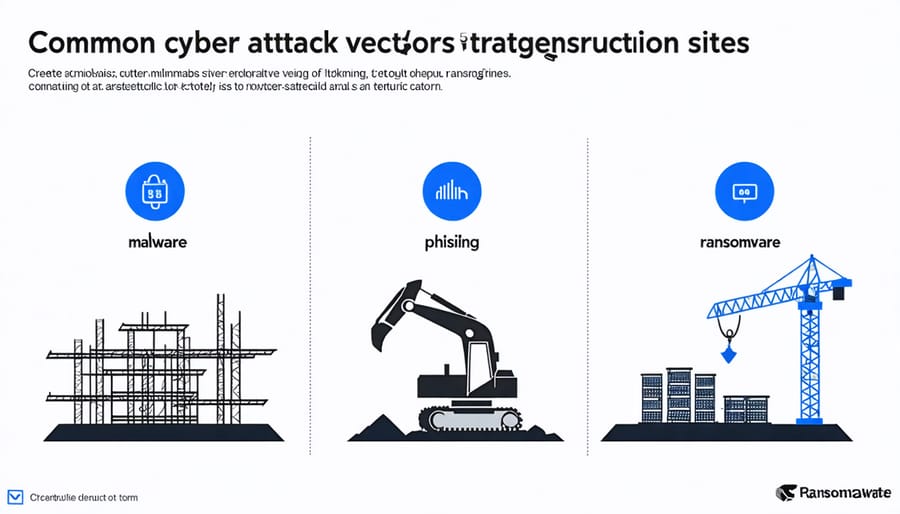The digitalization of construction sites exposes critical infrastructure, intellectual property, and operational systems to unprecedented cybersecurity risks. From BIM software vulnerabilities to compromised IoT sensors monitoring structural integrity, cyber threats now pose as significant a risk to construction projects as physical safety hazards. Recent attacks have disrupted major developments worldwide, with ransomware incidents causing project delays averaging 3-6 weeks and damages exceeding $5 million per incident. Today’s construction leaders must integrate robust cybersecurity protocols into their project management frameworks, securing everything from cloud-based collaboration tools to automated equipment controls. The convergence of operational technology (OT) and information technology (IT) in modern construction demands a comprehensive security approach that protects both digital assets and physical infrastructure. As the industry rapidly adopts smart building technologies, AI-driven project management systems, and connected worksite solutions, establishing resilient cybersecurity measures has become fundamental to project success and stakeholder protection.
The Digital Transformation of Construction Sites
Critical Digital Systems in Modern Construction
Modern construction projects rely heavily on interconnected digital systems that enhance efficiency but also create potential cybersecurity vulnerabilities. Building Information Modeling (BIM) platforms serve as central collaboration hubs, containing sensitive project data, design specifications, and proprietary information. Project management software and cloud-based document sharing systems facilitate real-time communication and data exchange between stakeholders, while Internet of Things (IoT) devices monitor site conditions, equipment performance, and safety parameters.
Smart building systems, including HVAC controls, security systems, and energy management platforms, are increasingly integrated into construction projects from the ground up. Connected construction equipment and autonomous vehicles on job sites generate valuable operational data while requiring secure network connections. Financial systems managing project budgets, payments, and procurement processes contain critical business information that demands robust protection.
These digital technologies, while essential for modern construction operations, create an expanded attack surface for cybercriminals. The integration of these systems with enterprise networks and their connection to the internet necessitates a comprehensive cybersecurity approach that addresses both the construction phase and the completed building’s operational technology infrastructure.

Vulnerability Points in Connected Construction
Connected construction systems present several critical vulnerability points that require vigilant monitoring and protection. Building Information Modeling (BIM) platforms, project management software, and IoT devices are particularly susceptible to cyber threats due to their interconnected nature and multiple access points.
Cloud-based collaboration tools, while essential for modern construction operations, can become entry points for malicious actors if not properly secured. Remote access capabilities, especially those hastily implemented during the pandemic, may have security gaps that cybercriminals can exploit.
Smart building systems and automated equipment present another significant vulnerability area. Construction sites utilizing connected sensors, GPS tracking systems, and automated machinery must ensure these devices are protected against unauthorized access and manipulation.
Supply chain management systems and vendor portals are also potential weak points. Third-party integrations and vendor access to project data can create security breaches if not properly vetted and monitored.
Data transfer points between different systems and platforms remain particularly vulnerable. The movement of information between design software, project management tools, and financial systems creates multiple opportunities for data interception or corruption if not adequately encrypted and protected.
Real-World Cyber Threats in Construction

Recent Attack Patterns and Methodologies
Recent analysis reveals that cybercriminals are employing increasingly sophisticated methods to target construction firms, with several critical data security threats emerging in the past year. Ransomware attacks have become particularly prevalent, with criminals targeting project management software and Building Information Modeling (BIM) platforms to encrypt crucial project data and demand substantial payments.
Social engineering attacks have evolved to exploit the industry’s collaborative nature, with threat actors impersonating trusted suppliers or subcontractors to gain access to sensitive information. These attacks often leverage sophisticated phishing emails containing authentic-looking purchase orders, change requests, or bid documentation.
Mobile device exploitation has emerged as a significant concern, particularly targeting construction site personnel using tablets and smartphones for project documentation and real-time communications. Attackers are increasingly focusing on compromising cloud-based construction management platforms, seeking to access intellectual property, bid information, and client data.
Supply chain attacks have also intensified, with cybercriminals targeting vulnerable third-party software integrations commonly used in construction operations. Of particular concern is the rise in attacks against Internet of Things (IoT) devices deployed on construction sites, including security cameras, environmental sensors, and automated equipment monitoring systems.
Financial and Operational Impacts
The financial impact of data breaches in the construction industry can be devastating, with recent studies indicating that the average cost of a cyber incident exceeds $2.5 million for mid-sized construction firms. These impacts extend far beyond immediate financial losses, affecting project timelines, client relationships, and company reputation.
Operational disruptions caused by cyber attacks can halt construction projects for days or even weeks, leading to missed deadlines, contractual penalties, and increased labor costs. Recent industry analysis shows that construction companies experience an average downtime of 5-7 business days following a significant cyber incident, with recovery costs often exceeding initial damage estimates by 150%.
Direct financial consequences typically include ransomware payments, system recovery expenses, legal fees, and regulatory fines. However, the long-term impacts often prove more significant, including increased insurance premiums, lost business opportunities, and damaged client relationships. Small and medium-sized contractors are particularly vulnerable, with 60% of affected companies reporting significant cash flow problems in the months following an attack.
Moreover, the interconnected nature of modern construction projects means that a security breach at one contractor can ripple through the entire supply chain, affecting multiple stakeholders and potentially leading to litigation. Project owners increasingly require cyber insurance coverage and robust security measures as prerequisite conditions for contract awards, making cybersecurity a critical business consideration rather than just an IT concern.
Essential Security Measures for Construction Projects
Data Protection Strategies
Effective strategies for protecting digital assets in construction projects require a multi-layered approach. Implementation of end-to-end encryption for all project communications and data transfers serves as the foundation for robust security. This includes securing Building Information Modeling (BIM) files, financial records, and proprietary design specifications.
Construction firms should establish strict access control protocols, utilizing multi-factor authentication and role-based permissions to ensure sensitive information is only accessible to authorized personnel. Regular data backups, stored both on-site and in secure cloud environments, protect against data loss and ransomware attacks.
Network segmentation is crucial for isolating critical systems from potentially vulnerable devices. This approach involves creating separate networks for office operations, field devices, and Internet of Things (IoT) sensors used in smart construction applications.
Document management systems should incorporate version control and audit trails to track changes and access attempts. For project communications, using encrypted messaging platforms and secure file-sharing services helps maintain confidentiality when collaborating with external partners.
Regular security audits and penetration testing help identify vulnerabilities before they can be exploited. Training staff in cybersecurity best practices, including recognizing phishing attempts and maintaining strong passwords, remains essential for maintaining data integrity across all project phases.
Access Control and Authentication
Access control and authentication form the cornerstone of cybersecurity in modern construction operations. As projects increasingly rely on digital systems, implementing robust access protocols has become crucial for protecting sensitive data and critical infrastructure.
Multi-factor authentication (MFA) should be standard practice for all digital access points, including project management software, Building Information Modeling (BIM) platforms, and remote monitoring systems. This approach combines something users know (passwords), something they have (security tokens), and something they are (biometric data), creating multiple layers of security.
Role-based access control (RBAC) ensures that employees, contractors, and stakeholders can only access information relevant to their responsibilities. For instance, subcontractors might need access to specific project drawings but should be restricted from financial data or sensitive client information.
Construction firms should maintain detailed access logs and conduct regular audits to track system usage and detect potential security breaches. Implementation of Single Sign-On (SSO) solutions can streamline access while maintaining security across multiple platforms.
Physical access control is equally important, particularly for server rooms and locations housing critical IT infrastructure. Smart card systems, biometric readers, and electronic logging systems help monitor and control site access while creating an audit trail for security compliance.
Regular training sessions should educate staff about proper authentication protocols and the importance of maintaining strong passwords. Password policies should enforce complexity requirements and mandate regular updates to prevent unauthorized access.
Employee Training and Awareness
Employee training is the cornerstone of an effective cybersecurity strategy in construction operations. Regular training sessions should cover essential security practices, including password management, data handling protocols, and recognition of common cyber threats like phishing attempts and social engineering tactics.
Construction firms should implement a structured training program that includes both initial onboarding and ongoing education. New employees must receive comprehensive security awareness training before accessing company systems, while existing staff should participate in quarterly refresher courses to stay current with evolving threats.
Site managers and project leaders should emphasize the importance of mobile device security, as construction professionals frequently access sensitive project data through smartphones and tablets on job sites. Training should cover secure Wi-Fi usage, proper handling of USB devices, and protocols for reporting suspicious activities or potential security breaches.
Real-world scenarios and interactive workshops prove particularly effective in engaging construction personnel. These sessions should address industry-specific challenges, such as protecting Building Information Modeling (BIM) data, securing remote access to project management platforms, and maintaining the confidentiality of bid documents and client information.
Documentation of training completion and regular assessments help ensure compliance and identify areas requiring additional focus. Companies should also consider implementing a cyber incident response plan and ensuring all employees understand their roles during a security breach.

Future-Proofing Construction Cybersecurity
Emerging Technologies and Risks
The construction industry’s rapid technological advancement brings both opportunities and new cybersecurity challenges. Building Information Modeling (BIM), Internet of Things (IoT) sensors, autonomous equipment, and cloud-based project management platforms have become integral to modern construction operations, creating an expanded attack surface for cybercriminals.
Smart building systems and integrated workplace management solutions present particular vulnerabilities. These systems often connect HVAC, lighting, access control, and other building operations to centralized networks, making them potential entry points for malicious actors. The convergence of operational technology (OT) and information technology (IT) systems requires a new approach to security that addresses both digital and physical risks.
Emerging drone technology and remote monitoring systems, while improving site surveillance and progress tracking, also introduce data privacy concerns and potential security breaches. The increasing use of artificial intelligence and machine learning in construction automation creates additional vectors for cyber attacks, particularly through compromised algorithms or manipulated training data.
5G networks are enabling faster data transmission and real-time collaboration but require robust security protocols to protect sensitive project information. Additionally, the adoption of digital twins and augmented reality in construction planning creates valuable intellectual property that must be safeguarded against industrial espionage.
Construction companies must stay ahead of these evolving threats by implementing comprehensive security frameworks that address both traditional and emerging technologies. Regular security assessments, employee training, and partnership with cybersecurity experts are essential for protecting against these new risks.
Proactive Security Planning
In today’s rapidly evolving digital landscape, construction firms must adopt modern risk management approaches that anticipate and prepare for emerging cyber threats. This proactive stance requires a three-pronged strategy: continuous threat assessment, adaptive security frameworks, and regular system updates.
First, implement continuous threat monitoring systems that analyze potential vulnerabilities in real-time. This includes regular penetration testing of project management software, building information modeling (BIM) platforms, and IoT devices used on construction sites. Establish a dedicated security team or partner with cybersecurity firms specializing in construction technology to conduct these assessments.
Second, develop and maintain an adaptive security framework that can evolve with emerging threats. This framework should include incident response plans, data backup protocols, and recovery procedures specifically tailored to construction operations. Regular tabletop exercises and simulations help teams prepare for various cyber scenarios, from ransomware attacks to data breaches.
Finally, establish a systematic approach to updating and patching all digital systems. This includes not only office computers but also site-based devices, smart equipment, and automated systems. Create a comprehensive inventory of all digital assets and implement a regular schedule for security updates and firmware upgrades.
By incorporating these strategies into your organization’s security planning, you can better protect your digital infrastructure while maintaining operational efficiency and project continuity.
As construction technology continues to evolve, cybersecurity must remain a top priority for industry professionals. Implementing robust security protocols, conducting regular risk assessments, and maintaining up-to-date security systems are essential steps in protecting digital assets. Construction firms should focus on employee training, secure data management practices, and partnerships with cybersecurity experts to build a comprehensive defense strategy. Regular audits, incident response planning, and staying informed about emerging threats will help organizations maintain resilience against cyber attacks. Remember that cybersecurity is not a one-time investment but an ongoing commitment that requires continuous adaptation and improvement. By taking these proactive measures, construction companies can better protect their projects, data, and stakeholders while maintaining operational efficiency and competitive advantage in an increasingly digital industry.

